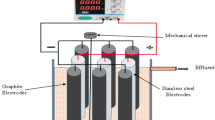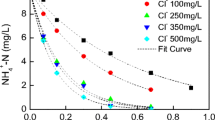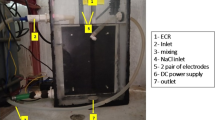Abstract
Although electrochemical disinfection has been shown to be an effective approach to inactivate bacteria in saline water, the effects of process parameters and reactor design for its application in low-salinity water have not been well understood. In this study, factorial experiments were performed to investigate the direct and confounded effects of applied current (5–20 mA), contact time (2.5–20 min), anode surface area (185–370 cm2), and chloride concentration (50–400 mg L−1) on the disinfection efficiency in fresh water and the secondary effluent of municipal wastewater. An electrochemical disinfection reactor cell with an internal volume of 75 cm3 was designed and fabricated. Residence time distribution analysis showed that the internal mixing of the reactor is similar to that of a dispersed plug-flow reactor. All studied process parameters showed significant effect on the kill efficiency, with the applied current and contact time having the most dominant effect. Although the effect of chloride concentration, which is responsible for electrochemical production of free chlorine in water, is statistically significant, it is not as prominent as those reported for high salinity water. A synergistic effect between chloride concentration and anode surface area was identified, leading to high kill efficiency (99.9%, 3 log kill) at low current density (0.0135 mA cm−2). Response surface modeling results suggested that a scaled-up disinfection reactor can be designed using large anode surface area with long contact time for high chloride water (400 mg L−1) or high current density with short contact time for low chloride water (50 mg L−1). The power requirement of a portable system treating 37.85 m3 day−1 (10,000 gpd) of municipal wastewater was estimated to be 1.9 to 8.3 kW to achieve a 3 log kill, depending on the reactor design.




Similar content being viewed by others
Availability of data and materials
All data generated or analyzed during this study are included in this published article [and its supplementary information files].
References
Abderrahmane S, Himour A, Ponsonnet L (2008) Inactivation of E-coli and Pseudomonas aeruginosa by electrochlorination under bipolar pulsed polarization. Mater Sci Eng C Biomim Supramol Syst 28:901–905
Antoniadis V, Tsadilas CD, Ashworth DJ (2007) Monometal and competitive adsorption of heavy metals by sewage sludge-amended soil. Chemosphere 68:489–494
Barashkova NN (2009) Electrochemical chlorine free AC disinfection of water contaminated with Salmonella typhimurium bacteria. Russ J Electrochem 46(3):306–311 320–325
Beggs KMH, Summers RS, McKnight DM (2009) Characterizing chlorine oxidation of dissolved organic matter and disinfection by‐product formation with fluorescence spectroscopy and parallel factor analysis. J Geophys Res 114(G04001). https://doi.org/10.1029/2009JG001009
Buchireddy PR, Bricka RM, Gent DB (2009) Electrokinetic remediation of wood preservative contaminated soil containing copper, chromium, and arsenic. J Hazard Mater 162:490–497
Cano A, Cañizares P, Barrera-Díaz C, Sáez C, Rodrigo MA (2012) Use of conductive-diamond electrochemical-oxidation for the disinfection of several actual treated wastewaters. Chem Eng J 211:463–469
Chalise PR, Perni S, Shama G, Novac BM, Smith IR, Kong MG (2006) Lethality mechanisms in Escherichia coli induced by intense submicrosecond electrical pulses. App Phys Lett 89(15):1–3.
Chen Y, Lin C-J, Jones G, Fu S, Zhan H (2009) Enhancing biodegradation of wastewater by microbial consortia with fractional factorial design. J Hazard Mater 171:948–953
Chen D, Che-Jen L, Jones RG, Patel S, Smith R, Simons K, Davis J, Waisner SA (2013) A deployable decentralized biofilm system for degrading organic carbon and benzene in wastewater. Environ Prog Sustain Energy 32:(3)505–511
Choi Y, Choi Y-j (2010) The effects of UV disinfection on drinking water quality in distribution systems. Water Res 44:115–122
Chu W-H, Gao N-Y, Deng Y, Krasner SW (2010) Precursors of Dichloroacetamide, an Emerging Nitrogenous DBP Formed during Chlorination or Chloramination. Environ Sci Technol 44:3908–3912
Cotillas S, Llanos J, Castro-Rios K, Taborda-Ocampo G, Rodrigo MA, Canizares P (2016) Synergistic integration of sonochemical and electrochemical disinfection with DSA anodes. Chemosphere 163:562–568
Dbira S, Bensalah N, Ahmad MI, Bedoui A (2019) Electrochemical Oxidation/Disinfection of Urine Wastewaters with Different Anode Materials. Materials 12(8)1254. https://doi.org/10.3390/ma12081254
Delaedt D, Daneels A, Declerck P, Behets J, Ryckeboer J, Peters E, Ollevier F (2008) The impact of electrochemical disinfection on Escherichia coli and Legionella pneumophila in tap water. Microbiol Res 163:192–199
Eaton AD, Clesceri LS, Greenberg AE, Franson MAH, American Public Health Association, American Water Works Association, Water Environment Federation (2005) Standard methods for the examination of water and wastewater, 21st Ed. American Public Health Association, Washington, DC
Fogler HS (2005) Elements of chemical reaction engineering, 4th edn. Prentice Hall, New Jersey
Gent DB, Wani AH, Davis JL, Alshawabkah A (2009) Electrolytic redox and electrochemical generated alkaline hydrolysis of hexahydro-1,3,5-trinitro-1,3,5 triazine (RDX) in sand columns. Environ Sci Technol 43:6301–6307
Ghasemian S, Asadishad B, Omanovic S, Tufenkji N (2017) Electrochemical disinfection of bacteria-laden water using antimony-doped tin-tungsten-oxide electrodes. Water Res 126:299–307
Gil MI, López-Gálvez F, Andújar S, Moreno M, Allende A (2019) Disinfection by-products generated by sodium hypochlorite and electrochemical disinfection in different process wash water and fresh-cut products and their reduction by activated carbon. Food Control 100:46–52
Grahl T, Markl H (1996) Killing of microorganisms by pulsed electric fields. Appl Microbiol Biotechnol 45:148–157
Gusmao ICCP, Moraes PB, Bidoia ED (2010) Studies on the electrochemical disinfection of water containing Escherichia coli using a dimensionally stable anode. Braz Arch Biol Technol 53:1235–1244
Huang X, Qu Y, Cid CA, Finke C, Hoffmann MR, Lim K, Jiang SC (2016) Electrochemical disinfection of toilet wastewater using wastewater electrolysis cell. Water Res 92:164–172
Jeong J, Kim JY, Yoon J (2006) The role of reactive oxygen species in the electrochemical inactivation of microorganisms. Environ Sci Technol 40:6117–6122
Jin Y, Shi Y, Chen R, Chen X, Zheng X, Liu Y (2019) Electrochemical disinfection using a modified reticulated vitreous carbon cathode for drinking water treatment. Chemosphere 215:380–387
Kerwick MI, Reddy SM, Chamberlain AHL, Holt DM (2005) Electrochemical disinfection, an environmentally acceptable method of drinking water disinfection? Electrochim Acta 50:5270–5277
Kraft A, Stadelmann M, Blaschke M, Kreysig D, Sandt B, Schroder F, Rennau J (1999) Electrochemical water disinfection - Part I: hypochlorite production from very dilute chloride solutions. J Appl Electrochem 29:861–868
Lacasa E, Tsolaki E, Sbokou Z, Rodrigo MA, Mantzavinos D, Diamadopoulos E(2013) Electrochemical disinfection of simulated ballast water on conductive diamond electrodes. Chem Eng J 223:516–523
Li XY, Ding F, Lo PSY, Sin SHP (2002) Electrochemical disinfection of saline wastewater effluent. J Environ Eng ASCE 128:697–704
Li XY, Diao HF, Fan FXJ, Gu JD, Ding F, Tong ASF (2004) Electrochemical wastewater disinfection: identification of its principal germicidal actions. J Environ Eng ASCE 130:1217–1221
Li H, Zhu X, Ni J (2011) Comparison of electrochemical method with ozonation, chlorination and monochloramination in drinking water disinfection. Electrochim Acta 56:9789–9796
Liu X, He Z (2020) Decreased formation of disinfection by-products during electrochemical leachate oxidation and their post-removal by electro-adsorption. Sci Total Environ 730:139171
López-Gálvez F, Posada-Izquierdo GD, Selma MV, Pérez-Rodríguez F, Gobet J, Gil MI, Allende A (2012) Electrochemical disinfection: An efficient treatment to inactivate Escherichia coliO157:H7 in process wash water containing organic matter. Food Microbiol 30:146–156
Luilo GB, Cabaniss SE (2010) Quantitative structure-property relationship for predicting chlorine demand by organic molecules. Environ Sci Technol 44:2503–2508
Montgomery DC, Runger GC, Hubele NF (2007) Engineering statistics, 4th edn. Wiley, New York
Nanayakkara KGN, Khorshed Alam AKM, Zheng Y-M, Paul Chen J (2012) A low-energy intensive electrochemical system for the eradication of Escherichia colifrom ballast water: Process development, disinfection chemistry, and kinetics modeling. Mar Pollut Bull 64:1238–1245
Palmas S, Polcaro AM, Vacca A, Mascia M, Ferrara F (2007) Influence of the operating conditions on the electrochemical disinfection process of natural waters at BDD electrodes. J Appl Electrochem 37:1357–1365. https://doi.org/10.1007/s10800-007-9368-3
Palmas S, Mascia M, Vacca A, Mais L, Corgiolu S, Petrucci E (2018) Practical aspects on electrochemical disinfection of urban and domestic wastewater. 421-447.
Pehlivanoglu-Mantas E, Hawley EL, Deeb RA, Sedlak DL (2006) Formation of nitrosodimethylamine (NDMA) during chlorine disinfection of wastewater effluents prior to use in irrigation systems. Water Res 40:341–347
Pernitsky DJ, Finch GR, Huck PM (1995) Disinfection kinetics of heterotrophic plate-count bacteria in biologically treated potable water. Water Res 29:1235–1241
Rahmani AR, Samarghandi MR, Nematollahi D, Zamani F (2019) A comprehensive study of electrochemical disinfection of water using direct and indirect oxidation processes. J Environ Chem Eng 7:102785
Schaefer CE, Andaya C, Urtiaga A (2015) Assessment of disinfection and by-product formation during electrochemical treatment of surface water using a Ti/IrO2 anode. Chem Eng J 264:411–416
Schaefer CE, Lavorgna GM, Webster TS, Deshusses MA, Andaya C, Urtiaga A (2017) Pilot-scale electrochemical disinfection of surface water: assessing disinfection by-product and free chlorine formation. Water Sci Technol Water Supply 17(2):526–536
Shah AD, Dotson AD, Linden KG, Mitch WA (2011) Impact of UV Disinfection combined with chlorination/chloramination on the formation of halonitromethanes and haloacetonitriles in drinking water. Environ Sci Technol 45:3657–3664
Sirivedhin T, Gray KA (2005) 2. Comparison of the disinfection by-product formation potentials between a wastewater effluent and surface waters. Water Res 39:1025–1036
Stoner GE, Cahen GL, Sachyani M, Gileadi E (1982) The mechanism of low frequency a.c. electrochemical disinfection. Bioelectrochem Bioenerg 9:229–243
Tchobanoglous G, Burton FL, Stensel HD, Metcalf & Eddy (2002) Wastewater engineering: Treatment and reuse, 4th Ed. McGraw-Hill, Boston
Tsolaki E, Pitta Paraskevi, Diamadopoulos E (2010) Electrochemical disinfection of simulated ballast water using Artemia salina as indicator. Chem Eng J 156:305–312
Varigala SK, Hegarty-Craver M, Krishnaswamy S, Madhavan P, Basil M, Rosario P et al (2020) Field testing of an onsite sanitation system on apartment building blackwater using biological treatment and electrochemical disinfection. Environ Sci Water Res Technol 6(5):1400–1411
Wang LS, Wei DB, Wei J, Hu HY (2007) Screening and estimating of toxicity formation with photobacterium bioassay during chlorine disinfection of wastewater. J Hazard Mater 141:289–294
Xu P, Janex ML, Savoye P, Cockx A, Lazarova V (2002) Wastewater disinfection by ozone: main parameters for process design. Water Res 36:1043–1055
Yamagiwa K, Shimizu H, Takahashi K, Yoshida M, Ohkawa A (2001) Disinfection kinetics of Legionella pneumophila by hydrogen peroxide. J Chem Eng Jpn 34:1074–1077
Yamagiwa K, Tsujikawa M, Yoshida M, Ohkawa A (2002) Disinfection kinetics of Legionella pneumophila by ultraviolet irradiation. Water Sci Technol 46:311–317
Yao Y, Kubota Y, Murakami T, Ochiai T, Ishiguro H, Nakata K, Fujishima A (2011) Electrochemical inactivation kinetics of boron-doped diamond electrode onwater borne pathogens. J Water Health 09(3):534–543
Funding
This study is supported by the Engineer Research and Development Center of the US Army Corps of Engineers under a subcontract issued by the Sam Houston State University (Project No: W912HZ-07-2-0010) and by the Sul Ross State University (Project No: W912HZ-11-1-0001).
Author information
Authors and Affiliations
Contributions
CJL: Formal analysis, investigation, writing - original draft, conceptualization, methodology, visualization, project administration; RZ: validation, formal analysis; SW: validation, formal analysis; TN: validation, formal analysis, writing - review & editing; LC: validation, formal analysis; DG: validation, formal analysis; JJ: validation, formal analysis; and SH: validation, formal analysis
Corresponding author
Ethics declarations
Ethics approval and consent to participate
Not applicable.
Consent for publication
Not applicable.
Additional information
Responsible Editor: Weiming Zhang
Publisher’s note
Springer Nature remains neutral with regard to jurisdictional claims in published maps and institutional affiliations.
Rights and permissions
About this article
Cite this article
Lin, CJ., Zhang, R., Waisner, S.A. et al. Effects of process factors on the performance of electrochemical disinfection for wastewater in a continuous-flow cell reactor. Environ Sci Pollut Res 28, 36573–36584 (2021). https://doi.org/10.1007/s11356-021-13193-1
Received:
Accepted:
Published:
Issue Date:
DOI: https://doi.org/10.1007/s11356-021-13193-1




